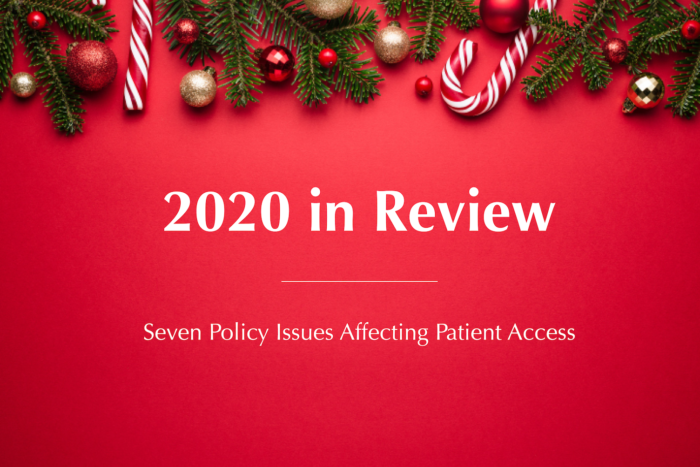2020 in Review: Seven Policy Issues Affecting Patient Access
December 18, 2020
COVID-19 dominated health care discussions this year, but it wasn’t the only topic that led to policy debate. Here’s a look back at seven issues that shaped health policy in 2020.

1. COVID-19 drew national attention to health policy.
The pandemic spurred an almost overnight explosion in the use of telehealth. Patients’ and providers’ growing reliance on the tool prompted policy discussions about how to make it more broadly available – and whether it might be here to stay. Meanwhile, COVID-19 sparked interest in other policies that could keep patients on track, such as access to home infusion for Medicare beneficiaries.
Learn more:
POSITION STATEMENT: Telehealth
PAPER: Fear Factor: Delaying Health Care During the COVID-19 Pandemic
GRAPHIC: Life Hacks: Telemedicine for Continuity of Care
VIDEO: Cardiovascular Care and Telemedicine
SURVEY: Treating Thyroid Eye Disease from Home
GRAPHIC: How Telemedicine Connects Patients to Respiratory Care
INTERVIEW: In Conversation: A Physician Discusses COVID-19 and Telemedicine
2. Public dialogue on racial disparities revived attention on health inequities.
As longstanding racial tensions came to head, the Alliance for Patient Access redoubled its commitment to addressing health disparities and fighting systemic inequities in the health care system. The organization pledged to continue advocating for policies that reduce health barriers, encourage optimal care for Black Americans and respect the needs of each individual patient.
Learn more:
STATEMENT: AfPA Statement on Health Disparities
BLOG: Health Data Gaps Widen Racial Divide
BLOG: Hurricane COVID
VIDEO: The Gap Baby: An RSV Story
3. Insurers lifted access barriers – but only for certain patients.
Concerns about coronavirus had insurers relaxing utilization management barriers like prior authorization for some patients, but not all. Meanwhile, as advocates asked “Will they or won’t they?” of CMS’ policy, employers embraced co-pay accumulators with gusto, leading to new cost concerns for patients. Calls to end the programs, which keep co-pay coupons from counting toward a patient’s annual deductible, are mounting.
Learn more:
VIDEO: Prioritizing Access for All Patients
VIDEO: Barriers to Patient Access: Co-Pay Accumulator Adjustment Programs
BLOG: Co-Pay Surprise Looms for Chronic Disease Patients
VIDEO: Step Therapy and Skin Conditions
4. ICER battered patients’ treatment hopes.
The pandemic didn’t slow the Institute for Clinical and Economic Review from deeming yet more vital medications not worth their cost. As the stakes get higher and the value conversation more visible, patients and providers grow more committed to ensuring the policy dialogue includes the values that matter to patients.
Learn more:
BLOG: Heart Doctors Want ICER to Get Real
BLOG: ICER Report Adds Insult to Injury for Cystic Fibrosis Patients
BLOG: A Headache Specialist’s Experience with ICER
5. From diagnosis to payment, Medicare policies frustrated patients.
While Medicare coverage remains vital, its policies can pose challenges for patients. Some face arbitrary waiting periods for cancer diagnostics and others grapple with unmanageable out-of-pocket costs. Among the policies solutions that gained traction this year – an annual out-of-pocket cap for Part D prescription drug plans, along with a “smoothing” approach that would divide seniors’ medication costs into manageable monthly installments.
Learn more:
VIDEO: Medicare Part D & Out-of-Pocket Smoothing
BLOG: Access Issues Linger for Cancer Patients
GRAPHIC: Medicare Barriers to Cancer Diagnostics
PAPER: Why Medicare Matters for Movement Disorders
6. Patients, providers enjoyed new biologics and biosimilars.
A steady flow of new biologics and biosimilars continued to expand treatment options for patients with a range of diseases, from asthma to psoriasis, cancer to high cholesterol. New medications underscored the success of the biosimilars pathway – and equipped health care providers to continue delivering on the promise of patient-centered care.
Learn more:
VIDEO: Biologics and Biosimilars: Increasing Treatment Options
POLICY BRIEF: Precision Medicine: Redefining Care for Rheumatoid Arthritis
REPORT: National Policy & Advocacy Summit on Biologics
7. States pioneered policies to improve patient access and protect patient-centered care.
Lawmakers across the country didn’t let an unusual session curb their commitment to protecting patients. A new law addressing “bad drug” ads passed in West Virginia, while legislators in Louisiana and South Dakota established commonsense limits on step therapy. Meanwhile, states’ subscription pricing models for hepatitis C cures continued to encourage progress toward eliminating the disease.
Learn more:
BLOG: Lawmakers & Regulators Tackle “Bad Drug” Ads
VIDEO: The Subscription Solution
POLICY BRIEF: A Path to Hepatitis C Elimination
Join us again January 5, 2021 for another year of insights on these and other health policy issues. Happy New Year!
Categorized in: Blog

